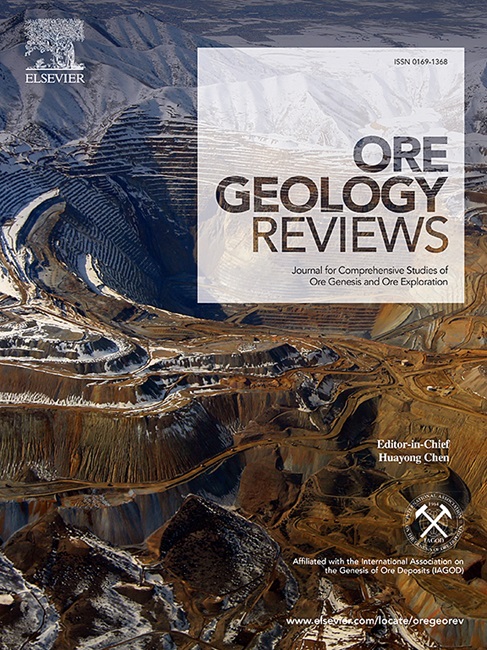Geology and antimony mineralization of the Yangla polymetallic orefield in northwestern Yunnan, SW China: Trace element geochemistry of sulfides and calcite
IF 3.2
2区 地球科学
Q1 GEOLOGY
引用次数: 0
Abstract
The Yangla is the largest and highest-grade antimony deposit (10 kt Sb @ 14.87 %) in the Jinshajiang suture zone, northwestern Yunnan (SW China). Pyrite and stibnite are the main sulfides, and calcite is the main gangue mineral in the antimony ores. Antimony mineralization can be divided into three stages: pre-ore stage pyrite and quartz, syn-ore stage (incl. early, main and late sub-stage) stibnite-pyrite-calcite-quartz, and supergene stage valentinite and limonite. The trace element compositions of the three pyrite and two stibnite generations have been analyzed by (LA-)ICP-MS here. The bulk ore-related calcite trace element compositions were also measured by ICP-MS. Trace element correlations and principal component analysis (PCA) show that the majority of trace elements occur as solid solution and micro-/nano-inclusions in pyrite and stibnite. In pyrite, the Sb substitutes into the crystal lattice with Tl, Cu and Ag via (Tl++Cu++Ag+) + Sb3+ ↔ 2Fe2+. Gold occurs as invisible gold (Au+) and enters pyrite via the coupled substitution of As3+ + Au3+ + □ ↔ 3Fe2+ and/or As3+ + Au3+ + □ ↔ 3Cu2+. In stibnite, the Cu, Pb and As enter the crystal lattice via the coupled substitution of 2Sb3+ ↔ Cu+ + Pb2+ + As3+. Trace element features of calcite are highly similar to the Devonian Linong Formation (2nd member) marble, suggesting that the ore-forming fluid is closely associated with the marble. Syn-ore calcite is characterized by its higher Fe, Mn and MREE concentrations, and can be regarded as a geochemical fingerprint for metallogenic prediction. The δCe (0.67–0.83, avg. 0.75) and δEu (1.40–2.51, avg. 1.89) values suggest that the antimony precipitation occurred under reducing to weakly oxidizing conditions. The atomic Yb/Ca, Yb/La, Tb/Ca, and Tb/La ratios of the syn-ore calcite imply that the antimony mineralization can be attributed to hydrothermal genesis. This deduction is also supported by that data of pyrite Ⅰ, Ⅱ, and Ⅲ mainly plotted inside the hydrothermal fields in the Co/Ni, As/Ag, Sb/Bi and Co-Ni-As discrimination plots. The Yangla stibnite ore samples mimic stibnite from typical hydrothermal mineralization systems (e.g., Woxi Au-Sb-W deposit, South China) in the Cu vs. Pb plot, which further supports a hydrothermal origin of the antimony. Therefore, we propose that the hydrothermal Sb mineralization is closely related to the Devonian carbonate rocks at Yangla.

中国西南部云南西北部羊拉多金属矿区的地质与锑矿化:硫化物和方解石的微量元素地球化学
羊拉锑矿是云南西北部金沙江缝合带(中国西南部)最大、品位最高的锑矿床(10 kt Sb @ 14.87 %)。黄铁矿和闪锌矿是锑矿的主要硫化物,方解石是主要的煤矸石矿物。锑矿化可分为三个阶段:前矿阶段黄铁矿和石英,同矿阶段(包括早期、主阶段和晚期亚阶段)黄铁矿-黄铁矿-方解石-石英,超生阶段戊铁矿和褐铁矿。这里采用 (LA-)ICP-MS 分析了三代黄铁矿和两代闪锌矿的微量元素组成。与矿石相关的方解石微量元素组成也是通过 ICP-MS 测定的。微量元素相关性和主成分分析(PCA)表明,大部分微量元素以固溶体和微/纳米包裹体的形式存在于黄铁矿和闪长岩中。在黄铁矿中,锑通过 (Tl++Cu++Ag+) + Sb3+ ↔ 2Fe2+ 与 Tl、Cu 和 Ag 一起置换到晶格中。金以隐形金(Au+)的形式存在,并通过 As3+ + Au3+ + □ ↔ 3Fe2+ 和/或 As3+ + Au3+ + □ ↔ 3Cu2+ 的耦合置换作用进入黄铁矿。在锡石中,铜、铅和砷通过 2Sb3+ ↔ Cu+ + Pb2+ + As3+ 的耦合置换进入晶格。方解石的微量元素特征与泥盆系里农层(第二系)大理岩高度相似,表明成矿流体与大理岩密切相关。同步成矿方解石的特征是铁、锰和MREE含量较高,可作为预测成矿的地球化学指纹。δCe(0.67-0.83,平均 0.75)和δEu(1.40-2.51,平均 1.89)值表明,锑沉淀是在还原至弱氧化条件下发生的。同矿方解石的原子 Yb/Ca、Yb/La、Tb/Ca 和 Tb/La 比率表明,锑矿化可归因于热液成因。在Co/Ni、As/Ag、Sb/Bi和Co-Ni-As判别图中,黄铁矿Ⅰ、Ⅱ和Ⅲ的数据主要绘制在热液场内,也支持这一推断。在铜与铅的对比图中,羊拉闪长岩矿样与典型热液成矿系统(如华南巫溪金-锑-钨矿床)中的闪长岩相似,这进一步支持了锑的热液成因。因此,我们认为洋拉的热液锑矿化与泥盆纪碳酸盐岩密切相关。
本文章由计算机程序翻译,如有差异,请以英文原文为准。
求助全文
约1分钟内获得全文
求助全文
来源期刊

Ore Geology Reviews
地学-地质学
CiteScore
6.50
自引率
27.30%
发文量
546
审稿时长
22.9 weeks
期刊介绍:
Ore Geology Reviews aims to familiarize all earth scientists with recent advances in a number of interconnected disciplines related to the study of, and search for, ore deposits. The reviews range from brief to longer contributions, but the journal preferentially publishes manuscripts that fill the niche between the commonly shorter journal articles and the comprehensive book coverages, and thus has a special appeal to many authors and readers.
 求助内容:
求助内容: 应助结果提醒方式:
应助结果提醒方式:


